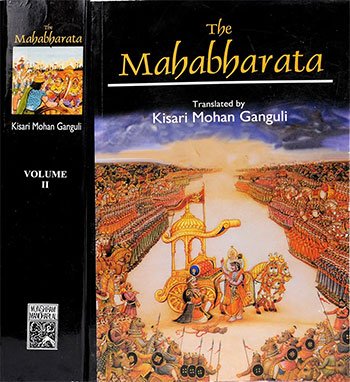Section CLVI - Duryodhana's Army Formation: Troops, Elephants, and Chariots
Book index: Mahabharata (English)
This page contains a summary of the Mahabharata Section CLVI including examples of moral lessons in daily life. The Maha-Bharata is one of the largest epics ever written containing roughly 100,000 Sanskrit verses. It deals with the legendary history of ancient India and contains a large number of interwoven tales.
Short summary of the chapter:
After distributing his troops into three classes and arranging them in proper order, King Duryodhana armed his army with various weapons, including clubs, spears, javelins, and poisonous snakes in pots. The army was decorated with golden robes, jewels, and gemstones, and the cars were equipped with bells, pearls, flags, and ornaments. Each car had four well-trained steeds and a skilled charioteer, making the army look like a fortress that was impossible to conquer. The elephants were decorated with bells, pearls, and diverse ornaments, while the foot-soldiers were accoutred with armours and weapons of different kinds.
The elephants carried seven warriors each, armed with hooks, bows, swords, lances, and tridents, presenting a formidable sight on the battlefield. The army also included thousands of steeds ridden by brave soldiers, all well-trained, ornamented, and obedient to their riders. Additionally, there were hundreds of thousands of foot-soldiers accoutred in varied armours and armed with different weapons, all decked in golden ornaments. The reserve force consisted of cars, elephants, horses, and foot-soldiers to rally the ranks that would be broken in battle.
The army formation was structured in terms of Senas, Pritanas, Vahinis, Dhvajinis, Chamus, Akshauhinis, and Varuthinis, with a total of eighteen Akshauhinis between the Pandava and Kaurava forces, the latter consisting of ten Akshauhinis and one more. Each Sena consisted of five times fifty men, and the mighty-armed king Duryodhana appointed brave and intelligent warriors, like Kripa, Drona, Salya, Jayadratha, and Karna, as leaders of his troops. These leaders were given an Akshauhini of troops each and were worshipped by the king daily, inspiring the warriors to fulfill the king's desires in battle.
Overall, the Kaurava army, under the leadership of King Duryodhana and his appointed warriors, was well-prepared and equipped for battle, with a strong formation and structure. The soldiers were ready and eager to fight, displaying loyalty to their king and determination to emerge victorious. Duryodhana's strategic arrangements and selection of skilled leaders demonstrated his meticulous planning and preparation for the imminent war against the Pandavas. The mighty force, adorned with ornaments and armed with various weapons, stood as a formidable opponent on the battlefield, ready to clash with the enemy forces and secure victory.
Full English translation:
This page is merely a summary which is automatically generated. If you are looking for authentic sources such as the Sanskrit text or the Full English translation of Mahabharata Section CLVI - Duryodhana's Army Formation: Troops, Elephants, and Chariots, have a look at the following articles:
Section CLVI, online text
English translation by Kisari Mohan Ganguli.
Read this and other chapters online.
Mahabharata (English Summary)
by Kisari Mohan Ganguli | ISBN-10: 8121505933
Buy the latest edition:
FAQ of Mahabharata, Section CLVI:
What was the total number of troops in Duryodhana's army?
Duryodhana's army consisted of ten Akshauhinis and one more, totaling eighteen.
How were the troops in Duryodhana's army organized?
Troops were divided into divisions with superior, middling, and inferior classes.
Who were the leaders of Duryodhana's army divisions?
Leaders included Kripa, Drona, Salya, Karna, and other brave warriors.
Daily life: Duryodhana's Army Formation: Troops, Elephants, and Chariots:
The narrative describes King Duryodhana meticulously organizing his army for battle, employing strategies that underscore the importance of planning and delegation in achieving objectives. In everyday life, this story can be a metaphor for the significance of preparing and organizing in order to tackle challenges effectively. Just like Duryodhana arranged his troops, elephants, and chariots into different ranks based on their capabilities, in daily life, tasks and responsibilities can be organized based on their priority and the expertise required to accomplish them.
Duryodhana’s method of equipping his units with a variety of tools and weapons illustrates the value of resourcefulness and being prepared for different scenarios. Similarly, in personal and professional endeavors, being well-prepared and adaptable to various situations can lead to success. Assigning specific roles to individuals based on their strengths, as Duryodhana did with his warriors, highlights the importance of delegation and acknowledging individual talents in team settings.
By creating reserves and backup plans, as shown in Duryodhana’s strategic military preparations, one can learn the importance of having contingency plans in life. Just as the King did, facing life’s battles requires foresight, adaptability, and the willingness to prepare for unforeseen challenges. This story emphasizes that success often comes to those who are well-prepared, organized, and capable of utilizing their resources and people effectively.
